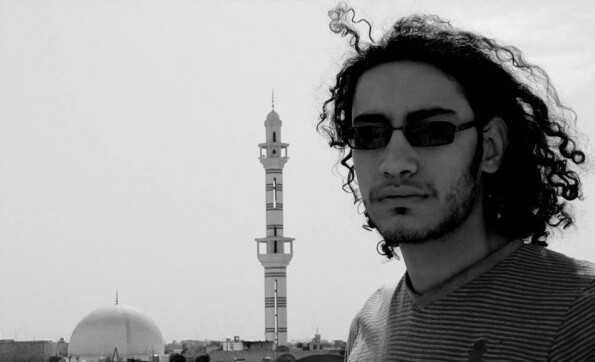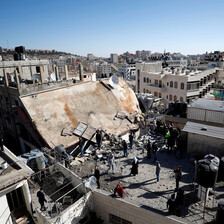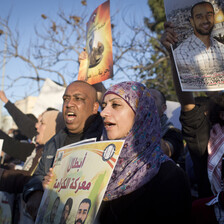The Electronic Intifada 6 June 2016

Niraz Saied (via Radio Yarmouk 63)
“My morale is higher than the MiG [warplane] that hit our home,” Niraz Saied wrote to me in January 2015. A few moments earlier a Syrian government air strike had targeted Yarmouk, the Palestinian refugee camp where he lived.
“There is no big deal, only the glass of the window was shattered,” he added. I could quickly tell he was downplaying the incident in an attempt to soothe me.
It was not the first time that the 24-year-old Palestinian photographer had stared death in the eye.
Like bread and gasoline, hope, too, was running out in Yarmouk. The largest Palestinian refugee camp in Syria had been bombed repeatedly. It had been under a complete siege since July 2013.
The siege, and the shortages it has produced, have resulted in the deaths of nearly 200 residents. It has also left its indelible scars on the pale faces of the survivors, the “children of the siege,” as Niraz referred to them.
“We live in a parallel world where time hardly matters and those outside are aliens to us,” Niraz told me at one point. “You cannot take anything for granted. The very fact that you are still alive strikes you as a surprise, not necessarily a happy one.”
By January 2015 life in the camp had already become virtually unlivable.
As if the blockade and constant shelling by Syrian government forces were not enough, residents were under an internal siege: one imposed by the Islamist militias vying for control in the camp, targeting activists critical of them and quashing personal freedoms under the guise of religion.
“Death is the norm”
“If you are fortunate enough to avoid death by starvation or shelling, you may be killed by a masked gunman accusing you of apostasy,” Niraz stated. “Death is the norm here. Life is the exception and civilians are targeted by everyone.”
Basic services were a luxury and human life appeared to be the only cheap commodity in the camp. But Niraz insisted on staying, despite appeals by his friends and loved ones to leave.
Niraz knew that the camp was ruined forever and that the days ahead could be even worse. He was not looking for praise.
“We remained here because we love this place,” he admitted. “We are not heroes and should not be expected to act like superhumans. We are tired of those lauding our defiance and scoring political points with our blood, while doing nothing to put an end to our suffering.”
When he returned to the camp in January 2013, Niraz was on a mission. Most war photographers tend to focus too much on death. He wanted to show that the camp still had room for life and love.
Through photography, which he has always regarded an art form, he sought to give visibility to the camp’s forgotten stories and to amplify the voices of those living and growing up under siege.
There were times when Niraz contemplated giving up his camera, when the wear and tear of war and siege were too much to bear. What kept him going was the memory of his fallen friends.
Right to dignity
“Giving up would be a betrayal to those who lost their lives defending the camp, defending our right to live in dignity,” he told me.
It was not until April 2015, when Islamic State fighters stormed Yarmouk, that Niraz finally fled. He first went to the nearby town of Yalda. Many of those displaced from Yarmouk — located on the southern outskirts of Damascus — had moved to Yalda, in search of safety.
“This place doesn’t resemble us. I feel like I was stripped of my heart after leaving Yarmouk,” Niraz told me over a bad Internet connection in June last year.
A month later, he managed to make his way out of Yalda into a government-held neighborhood in Damascus where he was hoping to stay for a while before finding a way out of the country. Niraz went into hiding because he risked arrest.
It looked as though things would finally get better for him.
The film Letters from Yarmouk was touring the world and the director Rashid Masharawi was collecting awards. The film would not have been possible had it not been for the photography and work of Niraz from inside the camp under extremely dangerous conditions.
I asked Niraz if it bothered him that he did all the hard work but that someone else was getting the credit. He replied: “The camp was destroyed and my friends were killed; I couldn’t care less about receiving credit for a film.”
In the months following his escape from Yarmouk, Niraz was barely available online. Words felt heavier than ever, the sense of defeat, of having lost everything, was too haunting.
Music was our main form of interaction, a sanctuary for Niraz. But even exchanging songs was a hard task with the incredibly slow Internet connection.
“I won my mini-battle against the slow connection and managed to listen to the song you sent me,” Niraz told me after finally managing to open a YouTube link. The link was for “To Mystiko” by the Greek singer Maria Farantouri.
“As long as we can enjoy those simple things, life is worth living,” Niraz added.
I assured Niraz that life will do him justice, that he will finally be able to reunite with his fiancée who is waiting for him in Germany, that many a small miracle can still emerge when least expected.
I was relieved that he managed to leave Yarmouk because that meant he was finally safe from the shelling and I thought this meant a new beginning. In Syria, however, safety is only relative.
Disappeared
Niraz was safe from the bombs but not from arrest.
He was apprehended by Syrian security forces on 2 September 2015. News of his arrest was only made public a month later. It was kept secret at the request of his family.
In our last conversation, a month before his arrest, I promised Niraz that he will be able to visit Jerusalem one day, that he will sit on the steps of Damascus Gate, and drink coffee in the Old City. He smiled, perhaps at the absurdity of this plan, and said, “I believe in your faith.”
Nine months since his arrest, Niraz’s whereabouts are unknown. He is one more than 1,000 Palestinian refugees languishing Syrian prisons, according to the Action Group for Palestinians in Syria. Like Niraz, the fate of many of those is unknown, their families desperately wanting to know whether they are dead or alive.
Among them is the Palestinian-Syrian software developer Bassel Khartabil, imprisoned by the Syrian government since 2012 and forcibly disappeared since October 2015. Palestinian student Oday Tayem, who turned 23 last month, has been forcibly disappeared since August 2013.
Palestinian activist Samih al-Bahra, a medical student at Damascus University, has been forcibly disappeared since 28 April 2013, when he was arrested from his home. His mother, a relief worker in the Eastern Ghouta region — who has also been arrested by Syrian security forces on three occasions since 2011 — has heard nothing but rumors about her son.
And the list goes on and on. Thousands of families in Syria are pleading with their loved ones to hang on, to come out of the dark cells.
Niraz often said that “the dream goes on.”
That was the title of his photography exhibition held in the occupied West Bank city of Ramallah two years ago.
Drawing strength from his own words, his fiancée, parents, sister and friends cling to one dream: to see Niraz, alive and free.
Budour Youssef Hassan is a Palestinian writer and law graduate based in occupied Jerusalem. Blog: budourhassan.wordpress.com. Twitter: @Budour48





